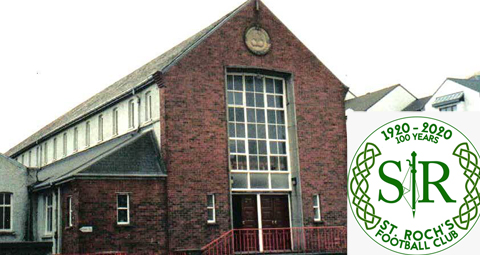June 7 | ![]() 0 COMMENTS
0 COMMENTS ![]() print
print

The saints who shape our communities: St Roch’s FC and support for refugees.
In the latest in his series, Ross Ahlfeld recalls his grandmother’s devotion as a cord-bearer, the centrality of women in nurturing the Faith, and how a saint influenced a message to immigrant at a city sports ground.
They say most football supporters can be classified into three distinct groups: despised ‘glory hunters’ with no loyalty to any club, ultra-loyal ‘cradle fans’ who remain hostages to their struggling hometown teams for life, and my tribe, ‘the sentimentalists.’
We are the type of fans who follow our home teams but also have other clubs on the side. This can be a team with which you fell in love while you lived in a particular town for a short while, a place where people treated you kindly. Or it can be a club which you associate with a much loved aunt or a cousin.
For example, my wee Granny Haggerty grew up in Leith supporting Hibernian FC, and when she moved to Greenock she used to watch out for their results every Saturday. As a result, I do too and whenever I’m in Edinburgh, I go and watch The Hibs play.
I still miss ‘wee Nan’ very much. Near the end her life we became very close. I sensed that her Catholicism was my Catholicism too. Nan’s Catholicism was a combination of prayer, hospitality and a rage against injustice.
Gift to her grandkids
This was her gift to all us very many grandchildren and great grandchildren. I used to visit her as often as I could and listen to stories of an impoverished Irish Catholic childhood in Edinburgh.
I’ve always felt that the Catholic Faith, like Judaism, is, emotionally, passed down through the maternal line in most working-class Catholic families.
Sure, our priesthood may be male but our Church is a mother and our Faith is nurtured and carried by strong women. From the women at empty tomb at the beginning of the Church, to women in leadership roles in the Church today, without whom there would simply be no Church.
For example, I’ve written often about the importance and efficacy of devotionals and sacramentals to our Faith and this is something which I learned from my grandmother. Hers was a Faith entirely free of intellectualism, rooted in the Rosary, endless Novenas, holy images, prayer cards, medals, scapulars and the living reality of the saints.
Prayers
Granny Haggerty was known to say ‘I’m tryin’ oot thon new saint, naw much guid sae far!’ We’d all laugh, but in reality Nan would have been spending long hours on her knees praying for us all, and for the wellbeing of a sick friend or neighbour, through the intercession of some newly canonised saint which she’d recently read about here in the pages of her much loved SCO.
At other times, she could be found petitioning more established saints, such as St Roch, a particular prayer card favourite, mainly because he was associated with travellers and healing illness.
St Roch was born around 1295 in southern France and like St Francis he gave away all his possessions to become a pilgrim for Christ. His devotion spread rapidly and today there are festivals in honour of him in many towns and villages in Northern Spain and Southern France.
My mum once told me about the time Wee Nan had to go into hospital for an operation, and stubbornly refused to remove an old frayed white cord which she had worn tightly girdled around her waist for many years.
A faithful devotion
This particular white cord was worn by cord-bearers who belonged to the Archconfraternity of the Cord, which was at one time quite a popular devotion found among the ordinary faithful.
Fascinatingly, the Confraternities of the Cord are affiliated to the Church of (the aforementioned) St Roch in Rome, where the Archconfraternity was revived by the Pope in the 19th century.
Unfortunately, these days the only cords you get in the church are the ones being worn by the guitar players in the parish music groups.
Maybe we should revive this pious devotion again, especially since you can simply go into any St Roch’s Church and have your cord blessed by the local parish priest.
The Garngad
Even if you are not having a cord blessed, I’d still recommend a visit to our very own St Roch’s parish church which sits within the part of Glasgow Archdiocese historically known as the Garngad.
The simple but beautiful bright and airy, red brick church of St Roch’s, designed by Walter R Watson, was opened in 1907 to cater for Irish immigrants who had settled in the area.
There had been a chapel dedicated to St Roch built in what is now known as the Royston area by James IV of Scotland in 1506 but the original chapel was destroyed during the Reformation.
The Candy Rock
While you’re in there you might also want to go and watch the local junior football team who are also called St Roch’s FC or ‘The Candy Rock’ as they are nicknamed.
If you do then you’ll probably be in for a treat. A while back, after spending the morning at the nearby Catholic Worker ‘Place of Welcome,’ I headed out to Royston to watch the Candy win 4-1 against Irvine Victoria.
The impressive performance wasn’t just confined to the pitch; while I was at the game, the fans were raising funds to pay for a local lad’s scholarship to the US.
Meanwhile the club were engaged in supporting various apprenticeships around the ground and organising after school homework clubs for local pupils.
Helping the poor
In the same way, the parishioners at St Roch’s Church volunteer at Fr Joe’s food exchange every Friday to distribute food to families in the Garngad experiencing hardship.
The most startling thing you’ll see on arrival at James McGrory Park is a mural on the wall behind the goal which reads ‘no one is illegal.’
This image reminded me of the motto associated with another radical football club, also named after a saint. Take a trip to watch FC St Pauli in Hamburg and you’ll see the exact same message everywhere you go ‘Kein Mensch ist illegal.’
Curiously, our friend Birke Kleinwaechter lives in a Christian community in Hamburg with immigrant families and homeless people, based on the principles of Catholic Worker.
The house is called ‘Brot und Rosen’ and is not too far from the Millerntor-Stadion where FC St Pauli play. Perhaps wherever there are alternative football clubs in struggling neighbourhoods, there are also alternative Christian communities too?
Solidarity
It would be a mistake however to think that all the cool and trendy ‘Love Candy, hate racism’ t-shirts which you see around St Roch’s on match day are being worn as a fashion statement. This is an area with a large immigrant population, so such displays of solidarity serve an important and practical purpose.
I know this because I’ve recently become involved with Citizens UK, whose Community Sponsorship foundation supports the resettlement of refugees into our communities.
Being involved with Citizens UK has taught me to appreciate just how hopeful displaced individuals from warzones feel when they see a ‘refugees welcome’ banner at clubs like St Roch’s or Celtic.
Despite all this social activism, the club still haven’t forgotten their roots; the memory of their patron saint still persists.
Marking the centenary
Next year St Roch’s will have been going for 100 years and to commemorate this milestone, the club have commissioned a centenary badge for next season. The excellent winning design by Scott McCorry was inspired by a depiction of St Roch as poor traveller taken from San Rocco Catholic Cathedral in Vienna.
Do, then, the saints have a particular role to play in communities which are defending the poor, challenging injustice and welcoming immigrants?
I would say absolutely yes. My friend (and fellow Catholic Worker) Gilbert Markus once told me about the time he visited a Dominican friary in Lima, Peru where he was made very welcome in a community of friars doing all kinds of work in education, hospitality, and solidarity.
St Martin de Porres
Gilbert described how the young novices had opened the grave of St Martin de Porres under his stone in the cloister, taken one of his bones, and then closed it again.
Every Tuesday afternoon they sat round a table and broke off tiny fragments from the bone, glued them onto a piece of card, put them into a tiny brass and glass reliquary, and sealed them.
The small relics were then delivered to supporters of their projects, and to friars working up in the mountains and Sisters in schools in the shanty towns and rural areas.
In this way the body was shared and made into a sign of solidarity, a connection, a method of support and a living presence amid hardship and struggle.
Social justice
Similarly, Dorothy Day co-founded the Catholic Worker Movement in New York during the midst of the Great Depression, devoting her life to prayer, serving the poor, and confronting the powers of the 20th century with her writing and speaking on behalf of social justice and peace.
I wonder what Dorothy Day would have made of St Roch’s own anti-establishment radicalism: good folks looking out for each other, while fighting against exploitation, a community which doesn’t have very much but nonetheless still shares what it has, welcoming strangers and honouring the patron saint.
Yes, I think Dorothy would have approved and so too would have Wee Nan.
So ‘Mon’ the Candy.’ May St Roch continue to pray for us and watch over the Garngad and all its people, no matter where they come from.










